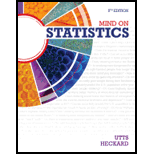
Mind on Statistics
5th Edition
ISBN: 9781285463186
Author: Jessica M. Utts, Robert F. Heckard
Publisher: Brooks Cole
expand_more
expand_more
format_list_bulleted
Concept explainers
Question
Chapter 1, Problem 1.28E
To determine
(a)
To explain:
Whether this a randomized experiment or an observational study.
To determine
(b)
To explain:
The conclusion can be made on the basis of this study.
To determine
(c)
To explain:
It was advisable to assign some of the participants to wear a placebo patch.
Expert Solution & Answer
Want to see the full answer?
Check out a sample textbook solution
Students have asked these similar questions
One study of cell phones and the risk of brain cancer looked at a group of 469 people who have brain cancer. The investigators then asked about the use of cell phones. Result: “Our data suggest that the use of hand- held cellular phones is not associated with risk of brain cancer.
B . Based on this study, can you determine that cellular use does not CAUSE brain cancer? Why or why not?
A scientist is studying the effect of a new type of
exercise program on cardiovascular health. The scientist
randomly assigns individuals to either the exercise
program or a control group. The scientist wants to
determine if the exercise program has a statistically
significant effect on cardiovascular health. The scientist
monitors cardiovascular health by measuring the blood
pressure of each individual.
Does ginkgo improve memory? The law allows marketers of herbs and other natural substances to make health claims that are not supported by evidence. Brands of ginkgo extract claim to “improve memory and concentration.” A randomized comparative experiment found no statistically significant evidence for such effects. The subjects were 350 healthy volunteers over 60 years old. They were randomly assigned to ginkgo or a placebo pill (a dummy pill that looks and tastes the same). All the subjects took a battery of tests for learning and memory before treatment started and again after six weeks.
(a) The study was double-blind. Why is this important?
(b) Can the results of this study be generalized to a larger population? Can cause-and-effect be inferred? Explain.
(c) Explain why it is advantageous to use 350 volunteers in this study, rather than, say, 30.
Chapter 1 Solutions
Mind on Statistics
Ch. 1 - Refer to the data and five-number summaries given...Ch. 1 - A five-number summary for the heights in inches of...Ch. 1 - In recent years, Vietnamese American women have...Ch. 1 - The risk of getting lung cancer at some point in...Ch. 1 - Refer to Case Study 1.3, in which teens were asked...Ch. 1 - Using Case Study 1.6 as an example, explain the...Ch. 1 - A CBS News poll taken in December 2009, asked a...Ch. 1 - A telephone survey of 2000 Canadians conducted...Ch. 1 - In Case Study 1.3, the margin of error for the...Ch. 1 - About how many people would need to be in a random...
Ch. 1 - Prob. 1.11ECh. 1 - Prob. 1.12ECh. 1 - Prob. 1.13ECh. 1 - For each of the studies described, explain whether...Ch. 1 - Prob. 1.15ECh. 1 - Suppose that an observational study showed that...Ch. 1 - A randomized experiment was done in which...Ch. 1 - Explain the distinction between statistical...Ch. 1 - A (hypothetical) study of what people do in their...Ch. 1 - Prob. 1.20ECh. 1 - Refer to Case Study 1.6, in which the relationship...Ch. 1 - Students in a statistics class at Penn State were...Ch. 1 - Prob. 1.23ECh. 1 - Prob. 1.24ECh. 1 - An article in the magazine Science (Service, 1994)...Ch. 1 - Prob. 1.26ECh. 1 - Prob. 1.27ECh. 1 - Prob. 1.28ECh. 1 - Refer to the study in Exercise 1.28, in which...Ch. 1 - Prob. 1.30ECh. 1 - Prob. 1.31ECh. 1 - Prob. 1.32ECh. 1 - Prob. 1.33ECh. 1 - Prob. 1.34ECh. 1 - Refer to Exercise 1.33. The Roper Organization...Ch. 1 - Prob. 1.36ECh. 1 - Prob. 1.37ECh. 1 - Prob. 1.38ECh. 1 - Prob. 1.39ECh. 1 - Prob. 1.40ECh. 1 - Prob. 1.41ECh. 1 - Suppose you were to read the following news story:...Ch. 1 - Refer to Case Study 1.5. Explain what mistakes...Ch. 1 - Refer to Case Study 1.6. Go through the five steps...
Knowledge Booster
Learn more about
Need a deep-dive on the concept behind this application? Look no further. Learn more about this topic, statistics and related others by exploring similar questions and additional content below.Similar questions
- What is meant by the sample space of an experiment?arrow_forwardWhat is an experiment? Give two examples.arrow_forwardIn a 2002 study conducted on 3000 Italian 15-year-old females, girls were asked how often they consume kaleeach week. Four years later, these answers were linked to the girls’ intelligence test scores as 19-year-olds. Thestudy found that girls who consume kale at least once a week scored higher on the intelligence test.Is this an experiment or an observational study? Explain. What is the explanatory variable? What is the response variable?arrow_forward
arrow_back_ios
arrow_forward_ios
Recommended textbooks for you
 Holt Mcdougal Larson Pre-algebra: Student Edition...AlgebraISBN:9780547587776Author:HOLT MCDOUGALPublisher:HOLT MCDOUGAL
Holt Mcdougal Larson Pre-algebra: Student Edition...AlgebraISBN:9780547587776Author:HOLT MCDOUGALPublisher:HOLT MCDOUGAL Glencoe Algebra 1, Student Edition, 9780079039897...AlgebraISBN:9780079039897Author:CarterPublisher:McGraw Hill
Glencoe Algebra 1, Student Edition, 9780079039897...AlgebraISBN:9780079039897Author:CarterPublisher:McGraw Hill College Algebra (MindTap Course List)AlgebraISBN:9781305652231Author:R. David Gustafson, Jeff HughesPublisher:Cengage Learning
College Algebra (MindTap Course List)AlgebraISBN:9781305652231Author:R. David Gustafson, Jeff HughesPublisher:Cengage Learning

Holt Mcdougal Larson Pre-algebra: Student Edition...
Algebra
ISBN:9780547587776
Author:HOLT MCDOUGAL
Publisher:HOLT MCDOUGAL

Glencoe Algebra 1, Student Edition, 9780079039897...
Algebra
ISBN:9780079039897
Author:Carter
Publisher:McGraw Hill

College Algebra (MindTap Course List)
Algebra
ISBN:9781305652231
Author:R. David Gustafson, Jeff Hughes
Publisher:Cengage Learning

Bayes' Theorem 1: Introduction and conditional probability; Author: Dr Nic's Maths and Stats;https://www.youtube.com/watch?v=lQVkXfJ-rpU;License: Standard YouTube License, CC-BY
What is Conditional Probability | Bayes Theorem | Conditional Probability Examples & Problems; Author: ACADGILD;https://www.youtube.com/watch?v=MxOny_1y2Q4;License: Standard YouTube License, CC-BY
Bayes' Theorem of Probability With Tree Diagrams & Venn Diagrams; Author: The Organic Chemistry Tutor;https://www.youtube.com/watch?v=OByl4RJxnKA;License: Standard YouTube License, CC-BY
Bayes' Theorem - The Simplest Case; Author: Dr. Trefor Bazett;https://www.youtube.com/watch?v=XQoLVl31ZfQ;License: Standard Youtube License